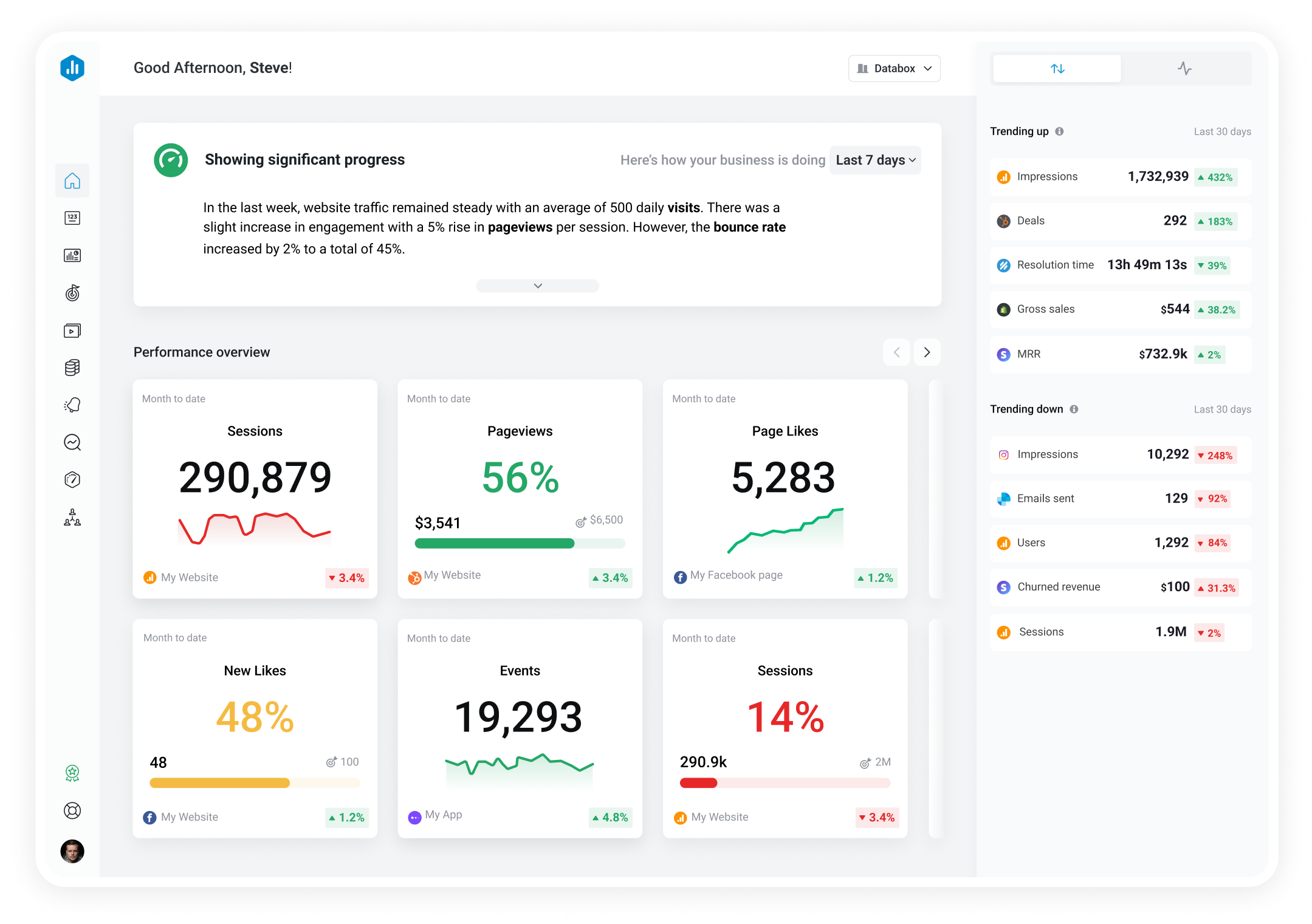Track all of your key business metrics from one screen
GET STARTED
 QuickBooks
Liabilities (Cash)
QuickBooks
Liabilities (Cash) Liabilities are financial obligations or debts owed by a business to creditors, suppliers, or other entities. It includes short-term, long-term, and contingent liabilities and is a measure of a company's financial obligations that must be paid in the future.
With Databox you can track all your metrics from various data sources in one place.
Liabilities represent the financial obligations or debts of a business entity or organization. These obligations come from past transactions or events, and they require the business to make future payments, provide goods or services, or settle outstanding debts.
Liabilities can be classified into two main categories based on their timing of settlement – current liabilities and non-current liabilities.
Depending on which type of liabilities you want to calculate, the formula you use will vary.
For current liabilities, you can use the following formula:
Current Liabilities = Accounts Payable + Short-term Loans + Accrued Expenses + Other Short-term Debts
For non-current liabilities, we use this formula:
Non-current Liabilities = Long-term Loans + Bonds Payable + Deferred Tax Liabilities + Other Long-term Debts
And lastly, here’s the formula we use to calculate total liabilities:
Total Liabilities = Current Liabilities + Non-current Liabilities
Let’s say a small business wants to calculate its liabilities based on the information provided below:
Current Liabilities:
Non-current Liabilities:
Let’s put the formulas to use.
First, we calculate current liabilities:
Current Liabilities = $10,000 + $5,000 + $3,000 = $18,000
Then, we move on to non-current liabilities:
Non-current Liabilities = $20,000 + $15,000 + $8,000 = $43,000
Lastly, total liabilities:
Total Liabilities = Total Current Liabilities + Total Non-current Liabilities Total Liabilities = $18,000 + $43,000 = $61,000
As we can see in this example, the company has total liabilities of $61,000.
To maintain financial health and be able to make informed debt management decisions, businesses need to track and analyze their liabilities effectively.
There are different approaches to this depending on the specific business model and industry, but we compiled a few universal strategies that any company might find useful:
More resources to help you improve:

Used to show a simple Metric or to draw attention to one key number.

Used to illustrate numerical proportions through the size of the slices.

Used to show comparisons between values.
Databox is a business analytics software that allows you to track and visualize your most important metrics from any data source in one centralized platform.
To track Liabilities (Cash) using Databox, follow these steps:
 Goals
Goals Scorecards
Scorecards Metric Digest
Metric Digest Metric Builder
Metric Builder Data Calculations
Data Calculations Performance Screen
Performance ScreenThe QuickBooks Balance Sheet Overview dashboard provides a real-time snapshot of assets, liabilities, and equity. It includes key financial metrics like liquidity, efficiency, solvency. Ideal for monitoring financial stability and performance.

Stay on top of your company’s financial health with real-time P&L, balance sheet, and cash flow insights from QuickBooks. Built for business leaders, finance teams, and stakeholders to support smarter planning and decision-making.

The two main types of liabilities are current liabilities and non-current liabilities.
Current liabilities are short-term financial obligations expected to be settled within one year, such as accounts payable, short-term loans, and accrued expenses.
Non-current liabilities are long-term financial obligations due beyond one year, including long-term loans, bonds payable, and deferred tax liabilities.
To truly understand your company’s liabilities, you need to stay on top of several related financial metrics.
Accounts payable, short-term loans, accrued expenses, bonds payable, and more, plus other financial KPIs that should be analyzed in conjunction with liabilities.
Now, while it’s possible to do this manually via extracting data from different tools and juggling it across multiple spreadsheets, using specialized software like Databox is a much more practical solution.
With Databox, you can connect all of these metrics and insights onto one comprehensive dashboard and have a real-time view of what’s happening.
You can connect any data source, pull out the metrics you want to track, and then visualize them in just a few minutes.
The best way to monitor current liabilities also comes down to compiling your most important metrics and figures in one place, so you can get the full picture of what’s happening in real time.
And instead of spending hours doing this manually and building a report in tools like Excel, it’s much easier to streamline the process with reporting software like Databox.
Both you and your team will have an instant view into what your numbers look like in real time and be able to catch any significant changes immediately as they occur.
